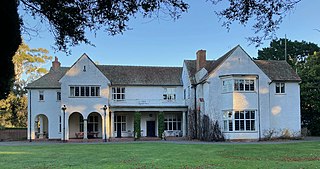| Fernside | |
|---|---|
 Fernside in 2015 | |
 | |
| General information | |
| Type | House |
| Architectural style | Neo-Georgian |
| Location | Featherston, New Zealand |
| Coordinates | 41°06′10.6″S175°21′54.2″E / 41.102944°S 175.365056°E |
| Completed | 1924 |
| Owner | Charles Elgar |
| Design and construction | |
| Architect(s) | Heathcote Helmore |
Fernside is a generous and luxurious five-bedroom white-weatherboard slate-roofed American Colonial Revival style house with an L-shape plan. It covers approximately 9,000 square feet or less than 1,000 square metres. There are three further bedrooms in the staff wing of the main house. Set by the Tauherenikau River on the plain below the junction of the Tararua and Rimutaka ranges Fernside was built in 1924 to replace a house destroyed by fire.
Contents
The current building is the work of the educated tastes of client, Ella, Mrs Charles Elgar and her 29-year-old architect, Heathcote Helmore.
The house is near Featherston down a tree-lined mile-long (1.6 kilometres) drive from State Highway 2 and surrounded by 12 acres of expertly maintained and landscaped gardens. The gardens have mature features much more than a century old. The associated farmland which gave it the title homestead has been under separate ownership since 1945.
Fernside is one of a small group of similar sized houses. This location let not-quite-absentee owners of remote coastal sheep stations live with easy access to the railway, main roads system and later, at the local Tauherenikau Racecourse, an airfield.
It has always been and remains a private residence. In the early 1990s before putting it up for sale an owner did offer a then rundown Fernside as an exclusive B & B lodge.
Fernside was the name of the district which is now a part of Tauherenikau. Fernside railway station, accessed from the far side of the railway line, closed in 1975.
The following critique is by Wellington architect Michael Fowler F.N.Z.I.A.
- "Fernside is approached from the main road along a mile-long drive of oak trees, which turns into a walled carriageway of fifty yards' length. Seldom has such conscious planning been devoted to the approach to a New Zealand house to dramatise the act of arrival. Nothing is overlooked: the iron grille gate in the side wall of the carriageway, through which one glimpses the gardens beyond; the solid timber arched door through the heightened forecourt walls, leading to the screened service yard, the radial paving in the circular court. This consistency is continued in the great Georgian house, with its two-floored, pedimented bay, its classic entranceway, the shuttered windows, the generous bracket eaves, the slate roof."
—Michael Fowler, architect and three-times Mayor of Wellington in his 1971 book Country Houses of New Zealand, North Island [1]
















